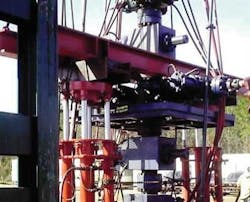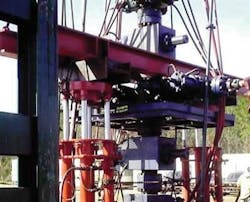Gene Kliewer - Technology Editor, Subsea & Seismic
When the Chevron-operated Tahiti development began production in 2Q 2009 as the deepest field in the Gulf of Mexico, it secured a place onOffshore’s Top 5 projects list. The fact that the $2.7-billion first phase of the project consists of six subsea wells in two drill centers, including the deepest producing well in the GoM at more than 26,700 ft (8,138 m) connected to a spar floating production system, cemented the recognition.
Chevron says production should plateau at 125,000 b/d of oil and 70 MMcf/d of gas by year-end from the field in Green Canyon blocks 596, 597, 640, and 641 in 4,000 ft (1,219 m) of water and more than 20,000 ft (6,096 m) below the seabed 190 mi (206 km) southwest of New Orleans. Production comes from beneath an 8,000 to 15,000 ft (2,438 to 4,572 m) thick salt canopy. Reserves estimates reach as high as 500 MMboe.
A 55-mi (88.5-km) crude oil pipeline connects Tahiti to the Amberjack pipeline. The line was built by Amberjack Pipeline Co. LLC and is owned by Chevron Pipe Line Co. and Shell Pipe Line Co. It starts in Green Canyon block 641 in 4,200 ft (1,280 m) of water and joins Amberjack in Green Canyon block 19. The pipeline was expanded from a 20-in. (50-cm) diameter to a 24-in. (61-cm) diameter to handle 300,000 b/d and accommodates additional discoveries in Walker Ridge and Green Canyon.
J Ray McDermott installed the infield flowlines, associated pipeline connections, and steel catenary risers (SCRs).
Early this year, Chevron awarded Cameron an $83-million order for Phase II of the Tahiti development. Phase II includes eight 15,000 psi subsea trees, production controls, connections, engineering and project management services, and related equipment. Delivery is scheduled to begin by this month and continue into 2012.
Along with that, the Tahiti platform is to get a deoxygenation system. The system, from Grenland Group, aims to remove oxygen from the injection water to reduce line corrosion and to prevent aerobic bacteria contamination of the producing zones. The system is to have a processing capacity of 100,000 b/d of water and is set for delivery in early 2011.
As might be expected from a record-setting project, there were several “firsts.” A new straked buoyancy module was developed by Flotation Technologies Inc. for Cameron’s use on Tahiti. The module has vortex-induced-vibration (VIV) suppression strakes incorporated to make one continuous helix. This buoys the jumpers while reducing the chances for damage by VIV.
Tahiti also was a test bed for Centek’s Close Tolerance centralizers in the GoM. The one-piece centralizers with a low friction coefficient were found to be flexible enough to compress and pass through restrictions in existing casing, but still expand to gauge in the open hole.
Tahiti at a glance
Discovered in 2002 in the Gulf of Mexico, estimated total recoverable reserves are 400-500 MMboe. Chevron is the operator with a 58% interest. Statoil at 25% and Total at 17% are the other partners. Tahiti is in 4,100 – 4,300 ft (1,250 – 1,311 m) water depth. The pay zone is beneath a salt canopy that ranges from 8,000 ft (2,438 m) to 15,000 ft (4,572 m) thick. The primary reservoir is 23,000 ft (7,010 m) to 28,000 ft (8,534 m) beneath the ocean bottom.
When tested in 2004, records were set for deepest completion at 27,000 ft (8,230 m) and longest frac pack ever pumped at 411 ft (125 m). Downhole pressure can reach almost 20,000 psi (138 MPa).
The truss spar structure is 128 ft (39 m) in diameter, 555 ft (169 m) long, and weighs 24,000 tons (21,772 metric tons). It is held in place by 13 mooring lines, Chervron’s first such use of polyester rope.
The topsides weigh 21,000 tons (19,051 metric tons), have 139,000 sq ft (12,914 sq m) of space, and can generate 30 MW of electricity. It has three parts, an 8,900-ton (8,074-metric ton) production module, a 5,900-ton (5,352-metric ton) utility module, and a 2,600-ton (2,359-metric ton) support frame.
Contractors involved with Tahiti include the following:
- Spar FEED – Technip
- Topsides FEED – Mustang Engineering
- Spar hull, monitoring systems – Technip
- Hull and mooring systems – Technip
- Topside modules – Gulf Marine Fabricators
- Infield lines – J Ray McDermott
- Reservoir management, production optimization – Roxar Flow Measurement





